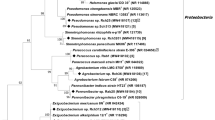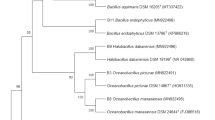Abstract
Several reports have highlighted that many plant growth-promoting endophytic bacteria (PGPE) can assist their host plants in coping with various biotic and abiotic stresses. However, information about the PGPE colonizing in the halophytes is still scarce. This study was designed to isolate and characterize PGPE from salt-accumulating halophyte Salicornia europaea grown under extreme salinity and to evaluate in vitro the bacterial mechanisms related to plant growth promotion. A total of 105 isolates were obtained from the surface-sterilized roots, stems, and assimilation twigs of S. europaea. Thirty-two isolates were initially selected for their ability to produce 1-aminocyclopropane-1-carboxylate deaminase as well as other properties such as production of indole-3-acetic acid and phosphate-solubilizing activities. The 16S rRNA gene-sequencing analysis revealed that these isolates belong to 13 different genera and 19 bacterial species. For these 32 strains, seed germination and seedling growth in axenically grown S. europaea seedlings at different NaCl concentrations (50–500 mM) were quantified. Five isolates possessing significant stimulation of the host plant growth were obtained. The five isolates were identified as Bacillus endophyticus, Bacillus tequilensis, Planococcus rifietoensis, Variovorax paradoxus, and Arthrobacter agilis. All the five strains could colonize and can be reisolated from the host plant interior tissues. These results demonstrate that habitat-adapted PGPE isolated from halophyte could enhance plant growth under saline stress conditions.

Similar content being viewed by others
References
Ali S, Charles TC, Glick BR (2014) Amelioration of high salinity stress damage by plant growth-promoting bacterial endophytes that contain ACC deaminase. Plant Physiol Biochem 80:160–167
Belimov AA, Hontzeas N, Safronova VI, Demchinskayaa SV, Piluzzac G, Bullittac S, Glick BR (2005) Cadmium-tolerant plant growth-promoting bacteria associated with the roots of Indian mustard (Brassica juncea L. Czern.). Soil Biol Biochem 37:241–250
Breckle SW, Scheffer A, Wucherer W (2001) Halophytes on the dry sea floor of the aral sea. In: Breckle SW, Veste M, Wucherer W (eds) Sustainable land-use in deserts. Springer, New York, pp 139–146
El Shaer HM (2010) Halophytes and salt-tolerant plants as potential forage for ruminants in the near east region. Small Ruminant Res 91:3–12
Flowers TJ, Colmer TD (2008) Salinity tolerance in halophytes. New Phytol 179:945–963
Glick BR (2004) Bacterial ACC deaminase and the alleviation of plant stress. Adv Appl Microbiol 56:291–312
Glick BR (2005) Modulation of plant ethylene levels by the enzyme ACC deaminase. FEMS Microbiol Lett 251:1–7
Glick BR (2012) Plant growth-promoting bacteria: mechanisms and applications. Scientifica. doi:10.6064/2012/963401
Glick BR, Todorovic B, Czarny J, Cheng Z, Duan J, McConkey B (2007) Promotion of plant growth by bacterial ACC deaminase. Crit Rev Plant Sci 26:227–242
Glickmann E, Dessaux Y (1994) A critical examination of the specificity of the Salkowski reagent for indolic compounds produced by phytopatogenic bacteria. Appl Environ Microbiol 61:793–796
Jha B, Gontia I, Hartmann A (2012) The roots of the halophyte Salicornia brachiata are a source of new halotolerant diazotrophic bacteria with plant growth-promoting potential. Plant Soil 356:265–277
Kim OS, Cho YJ, Lee K, Yoon SH, Kim M, Na H, Park SC, Jeon YS, Lee JH, Yi H, Won S, Chun J (2012) Introducing EzTaxon-e: a prokaryotic 16S rRNA gene sequence database with phylotypes that represent uncultured species. Int J Syst Evol Micr 62:716–721
Li L, Sinkko H, Montonen L, Wei G, Lindström K, Räsänen LA (2012) Biogeography of symbiotic and other endophytic bacteria isolated from medicinal Glycyrrhiza species in China. FEMS Microbiol Ecol 79:46–68
Lopez BR, Bashan Y, Bacilio M (2011) Endophytic bacteria of Mammillaria fraileana, an endemic rock-colonizing cactus of the southern Sonoran desert. Arch Microbiol 193:527–541
Lundberg DS, Lebeis SL, Paredes SH, Yourstone S, Gehring J, Malfatti S, Tremblay J, Engelbrektson A, Kunin V, del Rio TG, Edgar RC, Eickhorst T, Ley RE, Hugenholtz P, Tringe SG, Dangl JL (2012) Defining the core Arabidopsis thaliana root microbiome. Nature 488:86–90
Ma J, Zhang M, Xiao X, You J, Wang J, Wang T, Yao Y, Tian C (2013) Global transcriptome profiling of Salicornia europaea L. shoots under NaCl treatment. PLoS One 8:e65877
Ozawa T, Wu J, Fujii S (2007) Effect of inoculation with a strain of Pseudomonas pseudoalcaligenes isolated from the endorhizosphere of Salicornia europea on salt tolerance of the glasswort. Soil Sci Plant Nutr 53:12–16
Penrose DM, Glick BR (2003) Methods for isolating and characterizing ACC deaminase-containing plant growth-promoting rhizobacteria. Physiol Plant 118:10–15
Piccoli P, Travaglia C, Cohen A, Sosa L, Cornejo P, Masuelli R, Bottini R (2011) An endophytic bacterium isolated from roots of the halophyte Prosopis strombulifera produces ABA, IAA, gibberellins A1 and A3 and jasmonic acid in chemically-defined culture medium. Plant Growth Regul 64:207–210
Puente ME, Li CY, Bashan Y (2009) Rock-degrading endophytic bacteria in cacti. Environ Exp Bot 66:389–401
Qin S, Zhang YJ, Yuan B, Xu PY, Xing K, Wang J, Jiang JH (2014) Isolation of ACC deaminase-producing habitat-adapted symbiotic bacteria associated with halophyte Limonium sinense (Girard) Kuntze and evaluating their plant growth-promoting activity under salt stress. Plant Soil 374:753–766
Rashid S, Charles TC, Glick BR (2012) Isolation and characterization of new plant growth-promoting bacterial endophytes. Appl Soil Ecol 61:217–224
Redman RS, Kim YO, Woodward CJ, Greer C, Espino L, Doty SL, Rodriguez RJ (2011) Increased fitness of rice plants to abiotic stress via habitat adapted symbiosis: a strategy for mitigating impacts of climate change. PLoS One 6:e14823
Rodriguez RJ, Henson J, Van Volkenburgh E, Hoy M, Wright L, Beckwith F, Kim YO, Redman RS (2008) Stress tolerance in plants via habitat-adapted symbiosis. ISME J 2:404–416
Romero FM, Marina M, Pieckenstain FL (2014) The communities of tomato (Solanum lycopersicum L.) leaf endophytic bacteria, analyzed by 16S-ribosomal RNA gene pyrosequencing. FEMS Microbiol Lett 351:187–194
Rozema J, Flowers T (2008) Crops for a salinized world. Science 322:478–1480
Ryan RP, Germaine K, Franks A, Ryan DJ, Dowling DN (2008) Bacterial endophytes: recent developments and applications. FEMS Microbiol Lett 278:1–9
Schulz B, Boyle C (2006) What are endophytes? In: Schulz BJE, Boyle CJC, Sieber TN (eds) Microbial root endophytes. Springer, Berlin, pp 1–13
Sgroy V, Cassán F, Masciarelli O, Del Papa MF, Lagares A, Luna V (2009) Isolation and characterization of endophytic plant growth-promoting (PGPB) or stress homeostasis-regulating (PSHB) bacteria associated to the halophyte Prosopis strombulifera. Appl Microbiol Biotechnol 85:371–381
Sheng HM, Gao HS, Xue LG, Ding S, Song CL, Feng HY, An LZ (2011) Analysis of the composition and characteristics of culturable endophytic bacteria within subnival plants of the Tianshan mountains, Northwestern China. Curr Microbiol 62:923–932
Song J, Fan H, Zhao Y, Jia Y, Du X, Wang B (2008) Effect of salinity on germination, seedling emergence, seedling growth and ion accumulation of a euhalophyte Suaeda salsa in an intertidal zone and on saline inland. Aquat Bot 88:331–337
Weyens N, van der Lelie D, Taghavi S, Vangronsveld J (2009) Phytoremediation: plant-endophyte partnerships take the challenge. Curr Opin Biotechnol 20:248–254
Yildrim E, Donmez MF, Turan M (2008) Use of bioinoculants in ameliorative effects on radish plants under salinity stress. J Plant Nutr 31:2059–2074
Zhao S, Li L, Li SH, Wang HF, Hozzein WN, Zhang YG, Wadaan MA, Li WJ, Tian CY (2015) Actinotalea suaeda sp. nov., isolated from the halophyte Suaeda physophora in Xinjiang, Northwest China. Antonie van Leeuwenhoek 107:1–7
Acknowledgments
This work was supported by the Foundation of Chinese Academy of Sciences (Nos. 2015-XBQN-B-16, TSS-2015-014-FW-3-1, KFJ-SW-STS-141 and Y371162) and the Foundation of Science & Technology Department of Xinjiang Uygur Autonomous Region (QN2015BS017), and by the National Natural Science Foundation of China (No. 31300432).
Author information
Authors and Affiliations
Corresponding author
Ethics declarations
Conflict of interest
The authors declare that they have no conflict of interest.
Rights and permissions
About this article
Cite this article
Zhao, S., Zhou, N., Zhao, ZY. et al. Isolation of Endophytic Plant Growth-Promoting Bacteria Associated with the Halophyte Salicornia europaea and Evaluation of their Promoting Activity Under Salt Stress. Curr Microbiol 73, 574–581 (2016). https://doi.org/10.1007/s00284-016-1096-7
Received:
Accepted:
Published:
Issue Date:
DOI: https://doi.org/10.1007/s00284-016-1096-7




